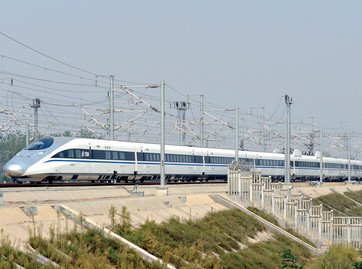The plan will mean a 24 percent increase in the length of China’s railway network from 2015 and a 58 percent expansion in high-speed rail.
The government will encourage state-owned China Railway Corp to expand bond issuance to finance its investment, Fei Zhirong, an official at the National Development and Reform Commission, told a new conference.
China aims to invest 800 billion yuan ($119.71 billion) in fixed assets in 2016 as part of the effort to expand the railway network.
China Railway invested 823.8 billion yuan in 2015, building 9,531 km (5,922 miles) of new lines which included 3,306 km of high-speed rail, according to state media.
By 2025, NDRC expects the network to total 175 000 route-km, of which 38 000 km of high speed rail.
NDRC says the rail network should be expanded to serve all cities with a population of more than 2 million, while all those above 5 million would be on the PDL network. The aim is to offer journey times of 1 h to 4 h between the principal conurbations, while trips across major urban areas should be possible in 2 h or less. NDRC also expects all principal ports and bulk commodity production areas to be served by rail.
The plan builds on the previous strategy of developing ‘four horizontal and four vertical’ axes by expanding these to eight in each direction. Most of the initial corridors are now nearing completion, and on some sections additional capacity is already required.
The eight ‘verticals’ (north – south trunk routes) are:
coastal PDL connecting Dalian and Dandong to Tianjin, Shanghai, Fuzhou, Shenzhen and Beihai;
capacity enhancements to the Beijing – Shanghai high speed corridor;
Beijing – Hong Kong PDL and connecting routes to serve intermediate population centres;
Harbin – Hong Kong PDL;
Hohhot – Nanning PDL via Datong, Taiyuan, Zhengzhou, Changde, Yongzhou and Guilin;
Beijing – Kunming PDL via Taiyuan, Xi’an and Chengdu/Chongqing;
Baotou/Yinchuan – Haikou via Yanan, Chongqing and Nanning;
Lanzhou/Xining – Guangzhou via Chengdu/Chongqing and Guiyang.
The eight east–west ‘horizontal’ axes are:
Suifenhe – Manzhouli via Harbin;
Beijing – Lanzhou via Hohhot and Yinchuan;
Qingdao – Yinchuan via Jinan and Taiyuan;
Lianyungang – Urumqi via Xuzhou, Zhengzhou and Xining;
Shanghai – Chengdu via Nanjing, Anqing, Wuhan, Yichang and Chongqing;
Shanghai – Kunming via Nanchang, Changsha and Guiyang;
Xiamen – Chongqing via Longyan, Changsha and Zhangjiajie;
Guangzhou – Kunming via Nanning.
In addition, NDRC has set out plans for construction of a network of new inter-regional corridors to cater for rising demand for short- and medium-distance trips. There is also a focus on using railway development as a tool for regeneration in the poorest regions, with around 12 new lines to be built for this purpose. Emphasising the role of intermodality in both the freight and passenger markets, it envisages a number of new passenger hubs and logistics centres.
The plan calls for expansion of the conventional network by around 20 000 km by 2025, with a focus on linking the Beijing/Tianjin region with the northeast, the Yangtse and Pearl river deltas and the northwest and southwest. Other enhancements would focus on improving links across the country over very long distances.
Finally, NDRC has reiterated the government’s commitment to enhancing international rail links through its ‘One Belt, One Road’ initiative. This confirms Chinese investment on various corridors through Central Asia and on enhancing rail links to Vietnam and other southeast Asian countries. Also envisaged is a rail tunnel linking the Chinese mainland to Taiwan.
SOURCES – Railway Gazette, Reuters

Brian Wang is a Futurist Thought Leader and a popular Science blogger with 1 million readers per month. His blog Nextbigfuture.com is ranked #1 Science News Blog. It covers many disruptive technology and trends including Space, Robotics, Artificial Intelligence, Medicine, Anti-aging Biotechnology, and Nanotechnology.
Known for identifying cutting edge technologies, he is currently a Co-Founder of a startup and fundraiser for high potential early-stage companies. He is the Head of Research for Allocations for deep technology investments and an Angel Investor at Space Angels.
A frequent speaker at corporations, he has been a TEDx speaker, a Singularity University speaker and guest at numerous interviews for radio and podcasts. He is open to public speaking and advising engagements.


